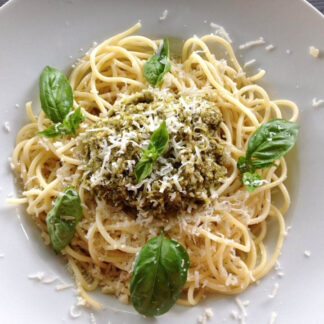Pesto Genovese (Authentic Italian Basil Pesto)
Pesto Genovese Pasta. On a cold day, forget a salad, let’s go for something a little more heartwarming and satisfying? Makes sauce for 400 g of pasta.
Ingredients
- 1 clove of garlic
- pinch of sea salt
- 1,5 cups fresh basil leaves, Genovese basil or buy fresh at the market, not too strong (50 g)
- 2 tablespoons pine nuts (30 g)
- 100 ml extra virgin olive oil (use a mild, fruity oil)
- 30 g Pecorino cheese or Grana padano cheese, finely grated
- 70 g Parmigiano Reggiano cheese, finely grated
Method
-
Prep the basil: Gently wash and pat completely dry. If using a salad spinner, let the basil sit briefly on a clean dish towel or paper towel to remove any remaining surface moisture before making pesto.
-
Food Processor Method: Place the basil, olive oil, garlic, pine nuts, and a pinch of salt in a food processor. Blend briefly on medium speed until roughly combined. Add the grated Parmesan and Pecorino, then pulse a few times until a coarse, thick paste forms. Avoid over-processing — the pesto should be slightly textured, not completely smooth.
If needed, add a little more olive oil and pulse again until you reach your preferred consistency. The pesto should be thick, but just barely pourable. Taste and adjust seasoning as needed.
-
Mortar & Pestle Method (Traditional): Finely crush the garlic and salt in the mortar. Add the pine nuts and continue to grind until smooth. Add the basil leaves gradually, one handful at a time, pounding them into a paste. Stir in the grated cheeses, then drizzle in some olive oil. Continue mixing and pounding until you achieve a fine, smooth, and creamy sauce.
-
Serving suggestion:Trofie and trenette are the traditional pasta choices in Liguria, but linguine or al dente spaghetti also pair beautifully with this sauce.
Important: Never cook pesto — always stir it into freshly drained, warm pasta off the heat to preserve its vibrant flavour and colour.
-
Enjoy!
Notes
- Shelf Life: Stored in an airtight container and covered with a thin layer of olive oil, pesto will keep in the fridge for about 2–3 days. For longer storage, freeze it in small portions (ice cube trays work perfectly).
- Serving Suggestion: In Liguria, pesto is traditionally served with Trofie or Linguine, often alongside potatoes and green beans—a classic combination that pairs beautifully.
- Pasta Tip: Add a halved potato to the pasta water while cooking. The extra starch helps the pesto cling better to the noodles.
- How to Use Pesto Properly: Never cook pesto! Always stir it into the warm, drained pasta just before serving. For the best texture and flavour, mix it with a bit of pasta cooking water until smooth. This keeps the colour vibrant and the taste fresh.
- Olive Oil: Use a mild, fruity extra virgin olive oil—ideally from Liguria—to enhance the flavour without overpowering the delicate basil.
- Lighter Option: For a milder, lower-calorie version, simply reduce the amount of Parmesan by half.
For a relaxing atmosphere in the kitchen I recommend my personal Elle Republic: Chilled Out Kitchen Tunes Playlist on Spotify.
